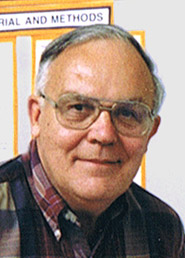Berkeleyan
Obituary
Robert Mortimer
![]()
08 November 2007
Robert K. Mortimer, an eminent yeast expert and professor emeritus of molecular and cell biology, died Aug. 10 from complications of Alzheimer's and Parkinson's diseases, it has been learned. He was 79.
 Robert Mortimer |
Mortimer was known worldwide for his role in making yeast one of the premier laboratory organisms in which to study the operations of genes and chromosomes. At a time when these one-celled fungi were much harder to study than the more popular fruit flies or corn or multi-celled fungi, he developed techniques that made the study of yeast DNA easy, paving the way for decades of fundamental genetic research. As he championed yeast for genetic studies, he also created a library of thousands of separate strains of Saccharomyces cerevisiae - the common brewer's or baker's yeast - that he freely offered to colleagues.
"Any investigator could browse the catalog and request any strain and receive it promptly for nothing more than the cost of a stamp," said Jasper Rine, professor of molecular and cell biology. "This generous service did much to create a culture of sharing, which still blesses the yeast genetic community to this day."
The Genetics Society of America recognized Mortimer in 2002 with the George W. Beadle Award for his many contributions to the creation of a community of approximately 10,000 researchers who strive to uncover more of the secrets of Saccharomyces.
Upon his retirement in 1991, Mortimer turned his attention to the strains of yeast used in making wine. He came to believe, as do many European winemakers, that fermentation by the naturally occurring, indigenous yeast on grapes produces a more complex wine. He met with many French, Italian, and California winemakers as he studied the "wild" yeasts in vineyards, presenting them with evidence that different strains of yeast work sequentially during fermentation to produce complexity. His work contributed to a growing American interest in natural-yeast fermentation instead of the use of industrial yeast.
Born in Didsbury, Alberta, Canada, in 1927, Mortimer graduated magna cum laude in physics from the University of Alberta in 1949, then enrolled as a graduate student in Berkeley's biophysics department. Working with Cornelius Tobias, the late Berkeley professor of medical physics, he explored the mechanisms used by yeast to repair radiation and chemical damage to its chromosomes.
"The so-called RAD genes that were discovered in these studies are the foundation of most contemporary studies of how higher cells repair damage to their DNA," Rine said.
Mortimer obtained his Ph.D. in biophysics from Berkeley in 1953, served as an instructor for three years, then joined the faculty as an assistant professor of genetics in 1956. He became a full professor in 1966, chaired the division of medical physics from 1972 to 1978, and served as chair of the Department of Biophysics and Medical Physics from 1984 to 1987. He also was affiliated with Lawrence Berkeley National Laboratory, where he served for a year as acting director of the lab's Human Genome Project.
In addition to developing the field of yeast genetics, Mortimer set up a Saccharomyces stock center housing many thousands of strains of yeast that his group created, as well as strains obtained from other scientists. In his later years Mortimer also developed new strains of yeast with improved traits for wine fermentation.
After his retirement he became a visiting scholar at the University of Florence in Italy, collaborating for nearly a decade with researchers there and at the University of Bologna to produce eight papers on the varieties of yeast inhabiting Italian and California grapes and those involved in the natural fermentation process.
Mortimer's interest in single-celled fungi extended to the edible, multi-celled kind, and mushroom hunting was one of his favorite hobbies, along with fly fishing, hiking, and gardening.
Mortimer is survived by his wife Mary, of Berkeley; sons Douglas of Berkeley and Bruce of Paradise, Calif.; daughter Barbara Mortimer of Redwood City; and three grandchildren. He and his wife had a son, Donald, who died in 1993.
- Robert Sanders

